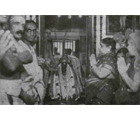Special Feature
Tyagaraja Aradhana In Tiruvaiyaru

The origin and evolution of the aradhana at Tiruvaiyaru, has been the subject of much research, resulting in many versions, thanks to our poor tradition of record keeping. The observance has acquired many dimensions over the years. Its history is chequered. It has not been smooth or solemn always, as the occasion warrants; there have been judicial interventions at times. References, with varying degrees of authenticity, are available only from the early 20th century. It is said that the saintcomposer himself had indicated that his memory would gain wider recognition only from 60 years after his siddhi.
It is interesting to note, that in the kriti, Dayajoochutakidi velara in the raga Ganavaridhi, perhaps among his last kriti-s, Tyagaraja seeks the grace of Daasarathi stating that he has fulfilled the tasks assigned to him by the Lord. (Munu neevaanatichchina panulaasakoni ne manasaaraga nidaanamuga salpinaanu vara Tyaagaraajaapta nanu).
Obituary
Vilayat Khan
Ustad Vilayat Khan (born: 1928), the sitar maestro, passed away at 23.25 hours on March 13, 2004, at the Jaslok Hospital in Mumbai after a brief illness. He is survived by his widow, Begum Zubeida, sons, Shujaat Khan and Hidayat Khan, and daughters, Yaman and Zilla. He is mourned by his family, and disciples of his gharana (stylistic lineage), along with three, perhaps four, generations of music lovers.
Hailed as an Ustad at the age of 17 at the Vikramaditya Music Conference in 1944, Vilayat Khan breathed his last in his 76th year. By this time, he had performed in every part of the world, made over a hundred commercial recordings, composed music for three feature films, rejected a string of official honours and titles, and become the predominant stylistic model for younger sitarists.


